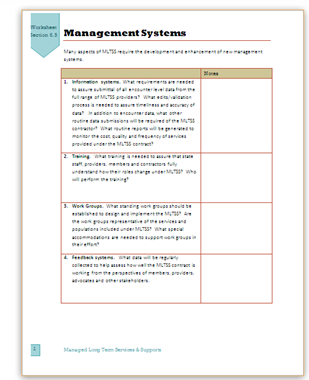Management Systems
MLTSS states identify several management systems that are critical to program success. These include the “hard” tools of technology as well as the “soft” value of working relationships.
- Information systems: The capacity to track and trend service use, cost and member information is critical to quality and financial oversight of the MLTSS program. MLTSS administrators emphasized the value of easy and timely access to information and the ability to query it when issues arise.
- Training: MLTSS places demands on providers, members, state personnel, and other stakeholders. Program directors caution others to not under-estimate the resources required to develop and conduct training and to make training available (and mandatory if appropriate) on an ongoing basis.
- Work Groups: The complex and multi-disciplinary nature of MLTSS requires that people work together to analyze problems, design solutions, and evaluate progress. In its formative stages, work groups can create buy-in and consensus on important aspects of program design. During implementation, work groups serve as important sounding boards on how to improve where the program is not working as intended. MLTSS veteran states, while acknowledging the time it takes to support work groups, see them as absolutely essential ways for engaging members, providers, the MLTSS contractors, and state policy makers in improving their programs.
- Active quality feedback systems: Member surveys and mandatory grievance systems are necessary but insufficient means for detecting and addressing problems in a timely manner. States are encouraged to find easy and ongoing mechanisms for members, providers, advocates and other stakeholders to provide formal and informal feedback on their experiences and ideas for improvement.
| Click to open Worksheet 6.5 for key considerations related to designing MLTSS Management Systems. |  |

